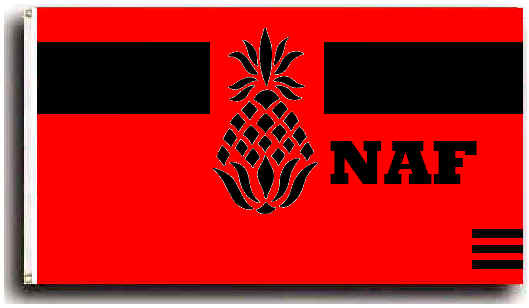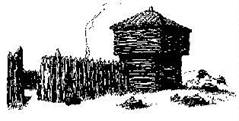|
.....
|
|

BUCK
CONNER
Staff Writer |
Smoke Signals
May./Jun. '09
|
Working
with Flintlocks
There have been dozens of books written on flints and
flintlocks, discussing the proper way to place the flint in the
hammer jaws, to sharpen the flint, and the speed of various
brands of flint locks. I
have been modifying and shooting flintlock rifles and pistols
for over forty years, and I doesn't think it makes any
difference which way you place the flint, bevel up or bevel
down, as long as it has a shower of sparks and the sparks fall
in the pan. Bevel up versus bevel down is more relevant to the
particular brand and style of lock that is being used and where
it hits the frizzen.
Thereís always the question of which is best flint:
knapped, cut, agate, black English, or manufactured flints? I
have used everything available, and they all work. It's more of
personal preference, I prefer the black English or French amber
flints. A
quality lock versus a junk lock is a no brainier. How fast the
hammer falls doesn't determine how fast the pistol or rifle
fires. There are many things that affect the ignition on a
flintlock. Condition of the frizzen, placement of the touch hole
or liner, shape of the touch holeĎs interior, sharpness of
flint all together determine how fast a flintlock will fire. A
rifle with the fastest lock that throws only one or two sparks
into the priming powder will not fire as fast as a rifle with a
slower lock that throws fifty sparks in the pan. How fast the
hammer falls is not that important to the average shooter. How
fast the rifle fires after the hammer falls is the most
important issue to the us.
Flints &
Knapping
A sharp flint is absolutely a must for good performance from
your flintlock. The fastest lock time cannot compensate for a
dull flint. An
old friend showed me years ago a simple and quick method to knap
a dull flint. The knapping tool was a piece of brass rod
1/2" in diameter by two inches long. To use the brass tool,
the hammer of the lock is placed at half cock with the frizzen
open and the pan empty of priming powder and weapon unloaded.
The piece of brass is held at a slight angle to the face of the
flint. Hit the cutting edge of the flint with a sharp rap from
the piece of brass. Dwayne uses the handle of his Green River
knife. The bottom of the flint face will flake off, leaving a
sharp new cutting edge. Two or three sharp raps may be necessary
for the desired clean, sharp edge you want.
A word of caution: NEVER test the sparking of
a new or sharpened flint on a loaded gun, even if there is no
prime in the pan. CAUTION use only brass or
bronze to prevent sparks. Aluminum is too light to be
effective, and steel could produces unwanted sparks. The brass
doesn't have to be 3/4" in diameter, and it doesn't have
to be round. Any diameter or shape from 1/2" to 3/4"
will work fine. Plus the piece of brass fits very nicely in
your possible bag or shooting box and can be found quickly.
Years ago we have watched people that never learned how to
knap their flints, just throw them away replacing them
with new ones. Back then flints were 15-20 cents each, but today
the cost of a good English flint is a $1 or more. Learn to knap
the edge on your dull flints and get your money's worth.
Your Frizzen.
The condition of the frizzen is very important to how the
lock sparks with a sharp flint. If the frizzen looks like a
"washboard", breaks up the edge of your flint, or
doesn't throw many sparks, it is time to clean up the face of
the frizzen and reharden it. The procedure that most use is very
easy. Heat treating is not that hard a process. The items you
need are: One wire clothes hanger; "Kasenit" surface
hardening compound sold at several of the muzzle loading
suppliers; Two quarts cheap 30-weight motor oil; one quart cheap
automatic transmission fluid; and two propane torches (one will
not generate enough heat). A word to the wise, do this outside
or in a well ventilated area. A friend loaned me a book on this
process written by George Shimel in 1947, here's
his method of caring for a frizzen. This is as clear as anything
anyone has ever written.
|
|
Mix
the oils together in a large coffee can or similar metal
container equipped with a lid for storage. Three quarts of
oil will stay cool longer and cool the metal best. CAUTION:
Do not use water, because it can cause fractures in the
metal by cooling too quickly. Remove the frizzen spring with
a spring vise, remove the frizzen from the lock. Smooth the
face of the frizzen on a six-inch coarse grinding wheel.
Going slow and grind off only enough metal to remove any
"wash board" and gouges visible. Grind vertically,
not across the frizzen. Don't worry about getting the
frizzen hot, you're going to heat treat it anyway.
Next, cut a section of
wire from the clothes hanger, about eight to ten inches
long. Run the wire through the screw hole in the frizzen and
wrap the wire tightly so the frizzen doesn't move around.
Pour about a cup of "Kasenit" into a shallow metal
can. A tuna can works very nicely. Clamp one of the torches
in a vise and light both torches. Heat the frizzen until it
is bright red throughout. It must be entirely heated to a
uniform color. Smother the heated frizzen in the
"Kasenit" until it is well coated. The
"Kasenit" will melt and adhere to the metal.
Immediately reheat again to a bright red color and cook it
for about three minutes. Be sure the entire frizzen is a
uniform bright red color and completely coated. After
cooking, quickly quench the heated frizzen in the oil
mixture and swirl it around to assure fast cooling. Leave
the frizzen in the oil until it is cool enough to handle.
Wipe the excess oil from the frizzen and repeat the
procedure for a second time. Itís recommended doing the
above procedure twice to assure a good deep hardening.
After the frizzen is
cooled enough to handle, clean it with acetone, alcohol, or
any degreasing agent. Remove it from the wire and polish the
face of the frizzen with 400 grit paper or emery cloth. Be
careful, and don't drop the frizzen on a hard surface
because it is brittle like glass and can break at this
point. Affix the frizzen back onto the wire and light one
torch. With a low flame starting at the pivot point and pan
lid, slowly and carefully heat the frizzen. This is called
drawing the temper back. Be sure that the color changes
uniformly. It will happen very quickly. When it reaches a
soft yellow/brown (STRAW) color, quickly quench it in the
oil and swirl around to assure uniform cooling. Leave in the
oil until completely cool. The ideal colors are between
straw and bronze. If you don't hit the straw color, but
maybe blue, don't worry, try it for sparking it will
probably be fine.
Remove the frizzen
from the oil and clean with a degreasing agent. Put a drop
of oil in the screw hole and install the frizzen and frizzen
spring back onto the lock. Test it using a new sharp flint.
It may take several attempts before you start getting
uniform sparking. After you start getting sparks, check to
see if there are any tiny metal shavings in the pan. If
there are, you have done it right. |
Touch Holes
& Liners
Usually the general thought is, "If there is a hole
through the barrel to the main powder charge the rifle will fire
just fine." This is true, but the results may not be what
you want. A proper touch hole (vent) liner is critical to the
speed that a flintlock will fire. I like permanent touch hole
liners in my rifles. My experience has been that the liners with
screwdriver slots or the hex head screws tend to collect fouling
and slow down your ignition. I like the type that requires using
a nipple wrench for installation and filing off the excess lug
so it's flush with the barrel flat. The more times you screw a
liner or nipple in and out of your rifle or pistol, the looser
it becomes. This common practice stresses and wears the threads
and increases the possibility of cross threading. That leads to
failure. Usually "blow outs" of liners and nipples are
the result of shooters frequently removing and reinstalling
these items. To replace a permanent liner, just drill out the
hole in the liner and remove it with an Easy-Out.
The inside of the liner should have a funnel-shaped interior
not a straight tube. Think about this: powder will go into a
funnel easier than into a tube. After drilling the diameter hole
that you want, use a cone or "Christmas tree"
shaped carbide cutter to shape the internal part of the liner to
a funnel shape. After the liner is installed in the barrel, I
seen some guys put a shallow cup shape in the outside face
of the liner with a ball type carbide cutter. With this type of
liner I can usually see powder grains in the touch hole after
loading the rifle. I don't "pick" the hole before
shooting, flashes in the pan are very rare. This internal shape
of the liner appears to create a self cleaning action. The
ignition is super fast, and I have never had a liner blow out.
The hole in a percussion nipple runs between .020 and .030 in
diameter, depending upon the manufacturer. This size hole is not
practical for good ignition in a flintlock. For best results I
use a liner with a .062 (1/16th.) hole for my flintlocks in .40
caliber or larger. For .32, .36, and .38 calibers, I like to use
a .050 hole in the liner. With the smaller powder charges that
are normally used in these small calibers, the .062 hole allows
too much jetting of main powder charge out of the touch hole.
This causes erratic pressures and affects the accuracy. The lag
time between the jetting and ignition of the main charge makes
it more difficult to hold through on the target in the offhand
position, especially with a flintlock pistol. The smaller hole
reduces the pressure loss from the main charge in a smaller
caliber. Replacing the touch hole liner when the hole gets about
.008 larger than the original hole size, or when the accuracy
falls off. A good, properly shaped liner should last for about
800 to 1000 shots, and thatís a lot of shooting.
The best hole gauge and vent pick that we have found is a set
of welding torch tip cleaning wires. These can be purchased at
any welding supply store. To check the size of the hole, insert
the largest wire that will fit into the hole, and then measure
the wire with a dial caliper or micrometer. If the hole is too
large, then replace the liner.
| REFERENCES
Ay Kroyd,W.R. The
Flintlock Rifle. Chicago: Quadrangle, 1937.
Crane,E.,ed. Masters of
the Flintlock. London: Heninernann, 1968.
Shimel,George Those Touchy
Flintlocks OK: University of Oklahoma Press, 1958.
Kramer,S.N. History
Flints & Their Locks. Philadelphia: University of
Pennsylvania Press, 1938.
Shoot
Straight. Respectfully
yours,
 
|
Buck Conner
.
NAF #3 Mountaineer
. AMM
#1641 Hiv.

|
___________________________
|